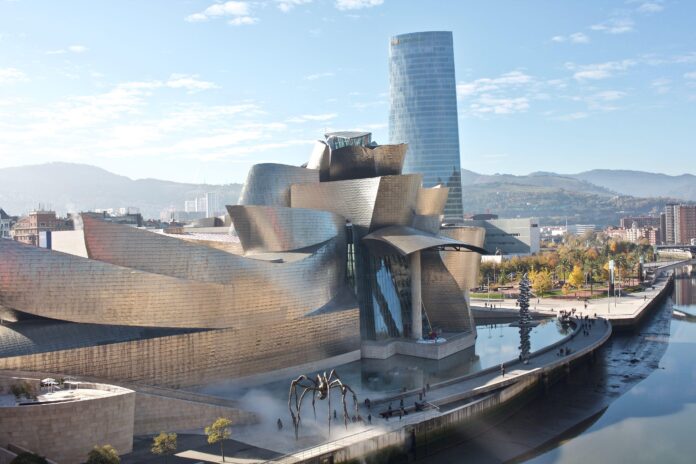When the Guggenheim Bilbao opened 25 years ago (18 October 1997), its architect Frank Gehry spoke of a “very strong mythology accepted by most architects: that a museum for art has to be [deferential] and neutral in order that it does not compete with the art”. And debate began almost as soon as the museum opened about whether, in resisting that tendency, he was demonstrating its wisdom.
In the book Design and Crime, Hal Foster wrote that Gehry’s spaces “trump” the post-war art they were intended to hold, using its scale “as a pretext to inflate the contemporary museum into a gigantic spectacle-space that can swallow any art, let alone any viewer, whole”. The Guggenheim was also notably critiqued in the artist Andrea Fraser’s video Little Frank and His Carp (2001), which lampoons the museum audioguide’s fetishisation of the building. Fraser said the Guggenheim’s lobby was “like a cross between a business hotel and an airport”.
This wasn’t a new debate, not even for the Guggenheim. In 1959, Frank Lloyd Wright’s building for the New York museum faced upstaging accusations. “On the contrary,” Wright said, “it was to make the building and the painting an uninterrupted, beautiful symphony.”

The inside spaces of the Guggenheim Bilbao can be a challenge for artists Photo: agefotostock / Alamy Stock Photo
My own Bilbao experience has been mixed. The Jenny Holzer LED texts commissioned for the atrium are a welcome, jarring counterpoint to the conditions Fraser describes. But in a vast show, Anselm Kiefer—an artist who needs no invitation to indulge excesses—seemed keen to engage Gehry’s spaces in a bombastic macho tussle, and came off bloodied.
When I spoke to the artist Do Ho Suh on our podcast A brush with…, he spoke of working in buildings designed by Rem Koolhaas and Zaha Hadid that also challenged the “mythology” Gehry decried, and found them “difficult to work with”. They are “works of art in themselves,” Suh said, “and I’ve found artists having a hard time to work around these spaces.” His solution: to use “transient” areas around the signature architectural structures.
Artists always find a way. But it’s notable that they rarely mention the Guggenheim Bilbao as an aspirational space. A useful counterpoint is the comparably spectacular Pompidou Centre. Despite the quirks of Richard Rogers and Renzo Piano’s building, its galleries are famously flexible, without fixed partitions or architectural obstacles. It’s a space “completely open to different contingencies and situations; a modular architectural space where the walls will appear and disappear”, as the French artist Philippe Parreno once told me.
That ultimately seems key to what artists want from museums: a context that liberates them. Of course, that can take many forms, and the Guggenheim Bilbao may well provide it for some artists—arguably it did for Fraser, in providing a catalyst for her particular brand of institutional critique.
A new exhibition, Sections/Intersections (19 October-22 January 2023), will show the acquisitions the Guggenheim has made over the past 25 years. We will see how successful it has been in creating a collection for a building that, a quarter of a century on, still divides critics as to how effectively it accommodates the art it hosts.

























